Table of Contents
Within the rich tapestry of Catholicism, a captivating realm of sanctity and spiritual luminosity emerges through the lives of remarkable individuals known as saints. These extraordinary men and women have left an indelible mark on the faith, embodying profound virtue, unwavering devotion, and a resolute connection to the Divine. Through their lives, we witness the transformative power of faith, the triumph of the human spirit, and the boundless potential for holiness.
In this exploration of Catholic saints, we embark on a journey through time, unraveling the stories of these luminous souls whose lives continue to inspire and guide us. From the early apostolic era to the Middle Ages and beyond, we encounter saints whose unwavering faith, selfless love, and remarkable deeds illuminate the path to spiritual growth and communion with God.
Each saint we encounter offers a unique lens through which we can explore different aspects of the human-divine relationship. Through their trials and triumphs, we witness the depth of their faith, the resilience of their spirits, and the timeless relevance of their teachings.
As we delve into the lives of these remarkable individuals, we invite you to embark on a journey of inspiration and reflection. Their stories remind us that sanctity is not confined to distant eras or extraordinary circumstances. Rather, it flourishes in the hearts and lives of ordinary individuals who, through their unwavering commitment to God, become vessels of His grace, transforming the world around them.
Join us as we dive into the extraordinary lives of these Catholic saints, drawing wisdom, inspiration, and spiritual nourishment from their remarkable journeys.
1. Saint Peter: The First Pope of the Catholic Church
St. Peter, one of Jesus’ twelve apostles, is regarded as the first Pope of the Catholic Church. Despite his initial denial of Jesus during His trial, Peter’s repentance and subsequent leadership formed the bedrock of the early Church. His life serves as a reminder of faith, repentance, and the power of God’s forgiveness.
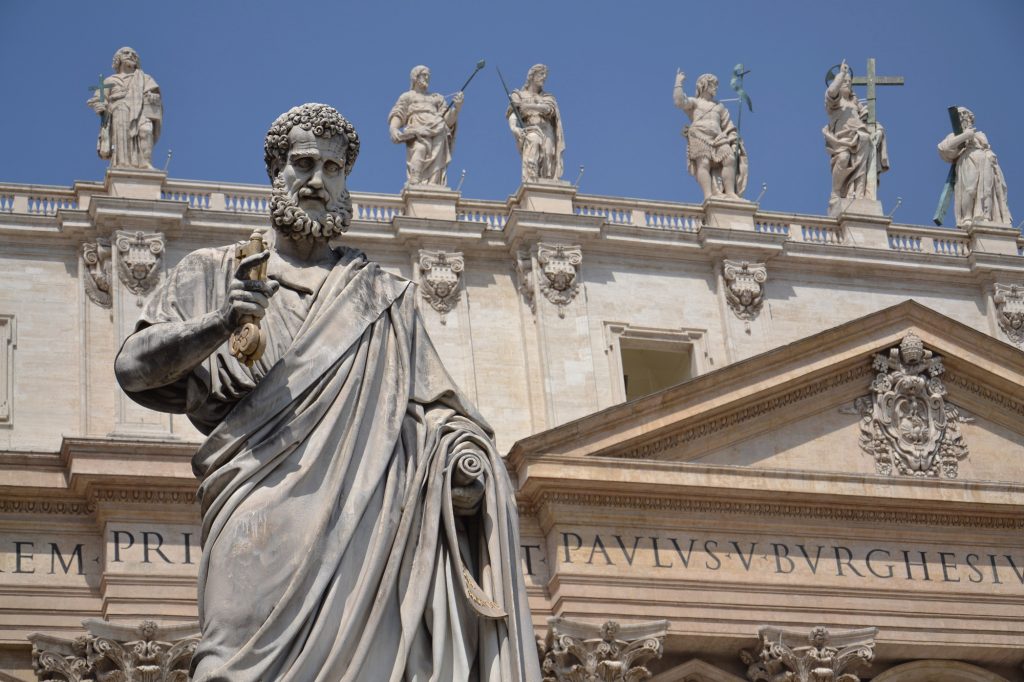
St. Peter, also known as Simon Peter or Simon bar Jonah, holds a revered position as the first pope of the Catholic Church. He played a pivotal role in establishing and shaping Christianity. In this article, we will explore how St. Peter became the first pope and highlight significant events from his life following the death of Jesus Christ.
The Primacy of St. Peter
According to Catholic tradition and the New Testament, Jesus Christ appointed St. Peter as the leader of the apostles, conferring upon him a unique authority. This appointment is commonly referred to as the “Primacy of St. Peter.” In the Gospel of Matthew (16:18-19), Jesus said to Peter:
“And I tell you that you are Peter, and on this rock I will build my church, and the gates of Hades will not overcome it. I will give you the keys of the kingdom of heaven; whatever you bind on earth will be bound in heaven, and whatever you loose on earth will be lost in heaven.”
This passage is interpreted by Catholics as Jesus entrusting Peter with the authority to govern and guide the Church, making him the first pope.
Life Highlights of St. Peter
Following the death of Jesus, St. Peter played a significant role in spreading his teachings and establishing Christian communities. Here are some notable highlights from his life:
1. Preaching and Ministry: St. Peter embarked on extensive preaching, both in Jerusalem and other regions. He performed miracles, such as healing the sick, and baptized numerous believers.
2. Martyrdom: St. Peter’s unwavering commitment to his faith led him to face martyrdom. According to tradition, during the reign of Emperor Nero, St. Peter was crucified upside down in Rome.
3. Epistles: St. Peter is traditionally believed to have authored two epistles in the New Testament, known as 1 Peter and 2 Peter. These letters offer guidance and encouragement to early Christian communities.
Legacy and Veneration
St. Peter’s legacy as the first pope and his steadfast faith have left an indelible mark on the Catholic Church. He is venerated as a saint and recognized as the patron saint of fishermen, Rome, and many other groups.
In conclusion, St. Peter’s position as the first pope holds immense significance in the history of Christianity. His leadership, ministry, and ultimate sacrifice continue to inspire millions of Catholics worldwide.
2. Saint Paul: From Persecutor to Missionary
St. Paul, originally known as Saul of Tarsus, stands as a remarkable figure in the history of Christianity. Despite starting as a fierce persecutor of Christians, his life took a dramatic turn when he experienced a profound conversion, becoming one of the most influential missionaries of the early Church. This article delves into the story of St. Paul’s conversion and highlights the enduring impact of his letters, which form a substantial part of the New Testament, guiding Christians in their faith journey.
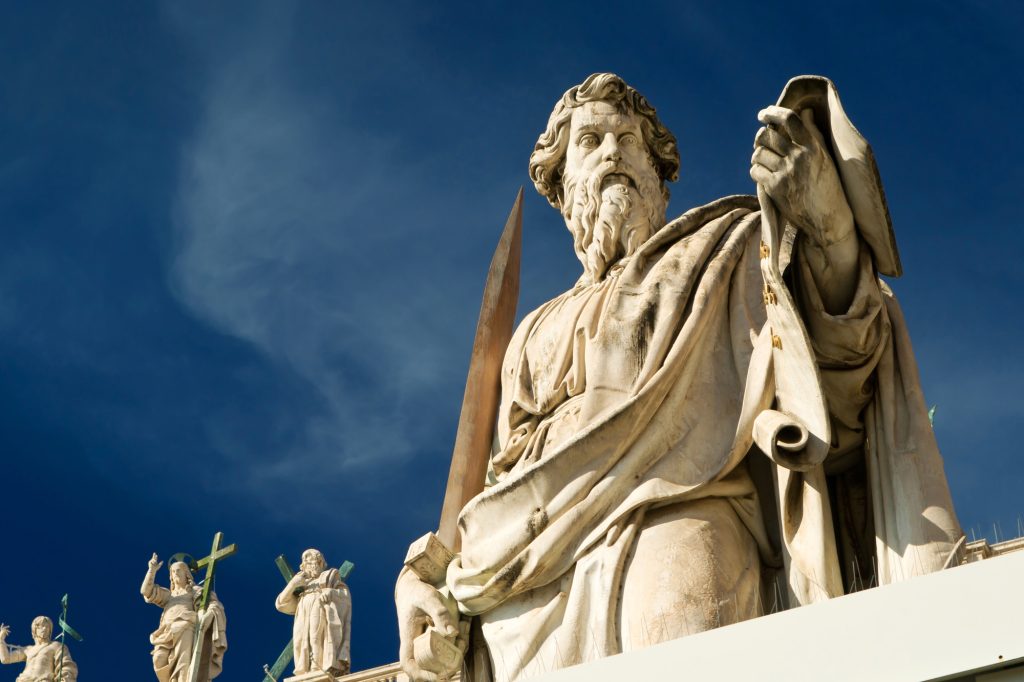
Saint Paul A Persecutor Transformed
Saul of Tarsus, a devout Jew, vehemently opposed the followers of Jesus Christ. He played an active role in persecuting and imprisoning early Christians, considering their teachings as a threat to Judaism. However, on his way to Damascus to carry out further persecution, Saul encountered a life-changing event.
The Road to Damascus
As Saul traveled to Damascus, a blinding light suddenly enveloped him, and he heard a voice saying, “Saul, Saul, why do you persecute me?” It was the voice of Jesus Himself. Trembling and astonished, Saul asked, “Who are you, Lord?” The response he received marked the beginning of his transformative journey: “I am Jesus, whom you are persecuting. Now get up and go into the city, and you will be told what you must do.”
A Conversion Experience
Blinded by the encounter, Saul was led into Damascus, where he fasted and prayed for three days. During this time, a disciple named Ananias received a divine instruction to visit Saul and restore his sight. Ananias obeyed, and as he laid his hands on Saul, the scales fell from his eyes, and he regained his vision. This miraculous event signified the spiritual transformation that had taken place within him.
From Saul to Paul: A Missionary’s Journey
Following his conversion, Saul, now known as Paul, dedicated his life to spreading the teachings of Jesus Christ. He embarked on multiple missionary journeys, traveling extensively to share the Gospel with both Jews and Gentiles, establishing Christian communities in various regions.
Paul’s Letters: Guiding Lights
St. Paul’s letters, also known as the Pauline Epistles, hold immense significance within the New Testament. Authored by Paul himself, these letters were written to different early Christian communities, offering guidance, encouragement, and theological teachings. They cover a range of topics, including faith, salvation, love, and the Church’s role. Today, these letters continue to serve as a valuable resource, guiding Christians in their faith journey and providing insights into the early Christian understanding of Christ’s message.
Legacy and Influence
St. Paul’s conversion and subsequent missionary efforts have had a profound and lasting impact on Christianity. His unwavering dedication to spreading the Gospel, coupled with his theological insights, shaped the early Church and continue to inspire believers worldwide. St. Paul is revered as a saint and recognized as one of the greatest evangelists in Christian history.
In conclusion, St. Paul’s transformation from a persecutor to a passionate missionary stands as a testament to the transformative power of faith. His letters, which form a significant portion of the New Testament, offer timeless wisdom, guiding Christians in their pursuit of a deeper understanding of God’s love and the teachings of Jesus Christ.
3. Saint Michael: The Mighty Archangel and his Battle Against Satan with the Fiery Sword
St. Michael, the powerful Archangel, holds a significant place in Catholic tradition and is renowned for his valiant battle against Satan and his role as the strongest of the Archangels, wielding a flaming sword. In this article, we will explore the story of St. Michael, his epic confrontation with evil, and his symbolism as a spiritual protector and warrior.
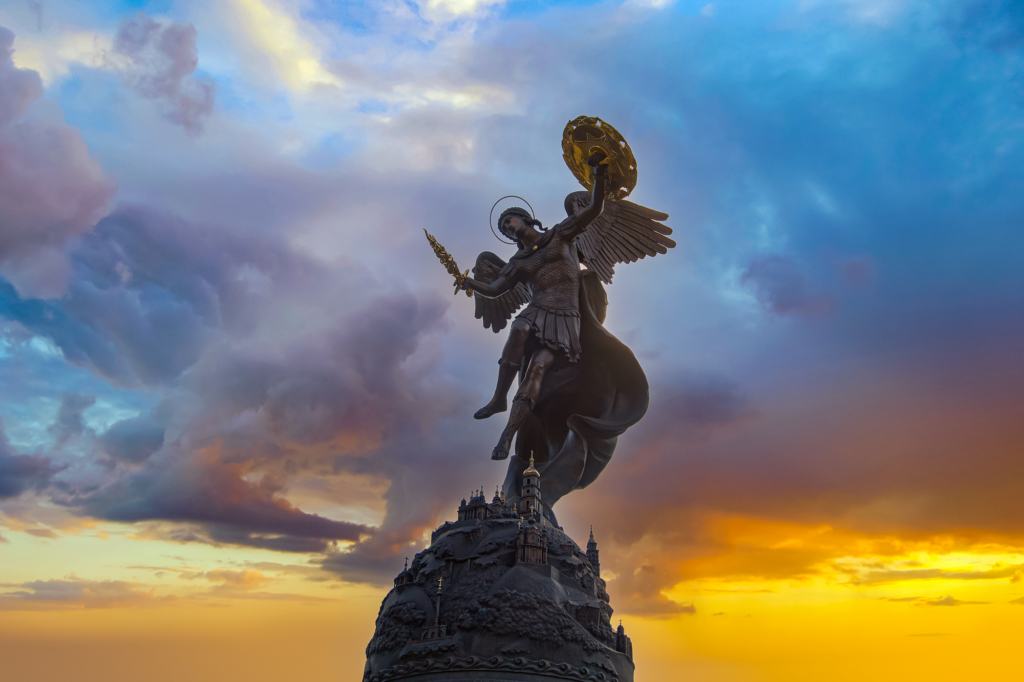
The Mighty Archangel St. Michael
St. Michael is often depicted as a celestial warrior, clad in armor and bearing a flaming sword. He is revered as the leader of the heavenly hosts and the champion of righteousness in the cosmic battle against evil. The name “Michael” means “Who is like God?” reflecting his unwavering loyalty and devotion to the divine.
The Battle Against Satan
One of the most famous accounts involving St. Michael is his dramatic battle against Satan. According to tradition, Satan and his rebellious angels sought to challenge the authority of God and were cast out of heaven. St. Michael, with his unwavering courage, led the faithful angels against the forces of darkness, triumphing over evil and banishing Satan from the heavenly realm.
Symbolism of the Fiery Sword
The depiction of St. Michael wielding a flaming sword symbolizes his role as a divine warrior and protector. The fiery sword represents his power and the divine authority entrusted to him to combat evil forces and defend the integrity of faith. It signifies the strength and determination needed to confront and overcome spiritual adversaries.
Guardian and Patron
St. Michael is revered as the guardian and protector of the Church and the faithful. His intercession is sought for strength, courage, and spiritual guidance. Many individuals and institutions, including the military and law enforcement, consider St. Michael as their patron, seeking his support in their noble endeavors.
In Search of Spiritual Protection
As believers navigate the challenges and temptations of life, the example of St. Michael serves as a source of inspiration and guidance. By emulating his unwavering loyalty and courage, individuals can strive to resist evil and embrace righteousness in their spiritual journey.
In conclusion, St. Michael, the mighty Archangel, stands as a symbol of unwavering faith and spiritual strength. His epic battle against Satan and his depiction with a flaming sword inspire believers to stand firm against the forces of darkness and seek divine protection in their daily lives. By invoking the intercession of St. Michael, individuals can find solace, guidance, and strength to overcome spiritual battles and embrace a life of holiness.
4. Saint Thomas Aquinas: The Angelic Doctor
St. Thomas Aquinas stands as a brilliant luminary of the Middle Ages, renowned for his extraordinary ability to harmonize faith and reason. His profound contributions to Catholic theology and philosophy continue to shape intellectual discourse and inspire seekers of truth. In this article, we will explore the life and legacy of St. Thomas Aquinas, focusing on his seminal work, the “Summa Theologica,” which remains a cornerstone of Catholic thought.
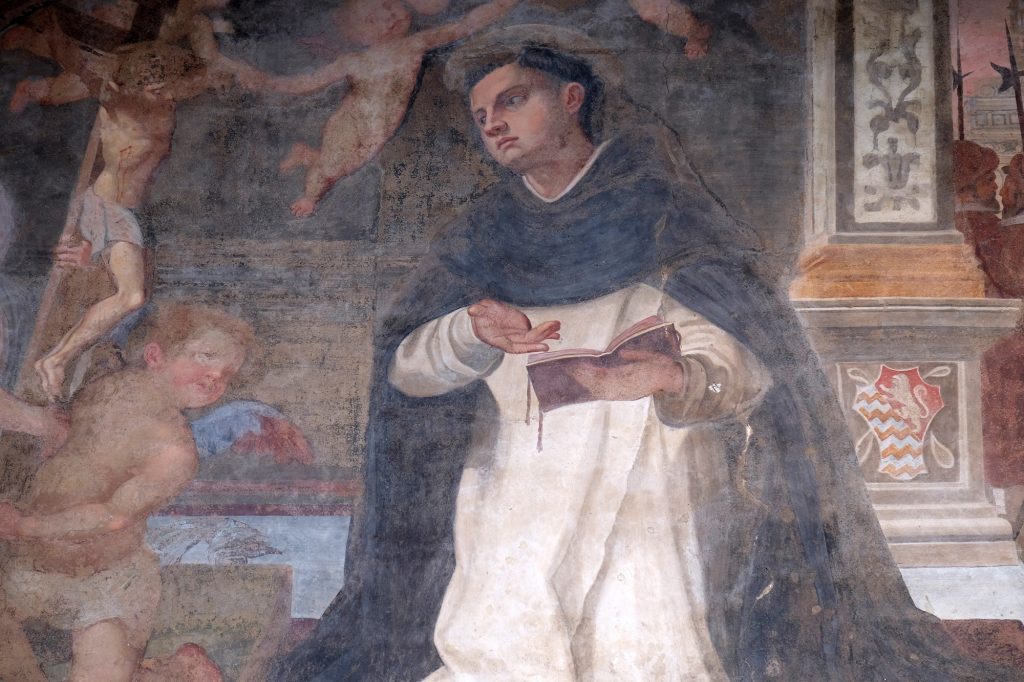
The Life of St. Thomas Aquinas
Born in Italy in the 13th century, St. Thomas Aquinas entered the Dominican Order against his family’s wishes, dedicating his life to the pursuit of knowledge and understanding. He studied under renowned scholars of his time and became known for his keen intellect and insatiable thirst for truth.
The Harmonization of Faith and Reason
St. Thomas Aquinas sought to reconcile the teachings of faith with the insights of reason, believing that both were essential for a comprehensive understanding of reality. He saw no conflict between faith and reason, considering them as complementary paths to truth, with faith illuminating what reason could not fully comprehend.
The “Summa Theologica”
St. Thomas Aquinas’ most significant work, the “Summa Theologica,” remains an unparalleled masterpiece of theological and philosophical inquiry. This extensive treatise covers a wide range of topics, providing comprehensive insights into the nature of God, human nature, ethics, and the interplay between faith and reason.
Divided into three parts, the “Summa Theologica” presents a systematic approach to addressing theological and philosophical questions. St. Thomas Aquinas meticulously examines arguments, provides counterarguments, and offers rational explanations rooted in both faith and reason. His approach serves as a guide for intellectual exploration and critical thinking.
Contributions to Catholic Theology
St. Thomas Aquinas made profound contributions to Catholic theology, shaping the understanding of God, morality, and the nature of humanity. His work emphasized the existence of God, the harmony between divine revelation and natural law, and the significance of human free will in moral decision-making.
Enduring Influence
St. Thomas Aquinas’ intellectual legacy extends far beyond his own time. His teachings continue to be studied, debated, and celebrated by theologians, philosophers, and scholars worldwide. The “Summa Theologica” remains a cornerstone of Catholic thought, guiding theological discussions and providing insights into the depths of human inquiry.
A Model of Integration
St. Thomas Aquinas’ life and work embody the integration of faith and reason, demonstrating the power of intellect in service to faith. His pursuit of truth through rigorous intellectual inquiry inspires individuals to seek understanding, engage in reasoned discourse, and embrace a holistic approach to knowledge.
In conclusion, St. Thomas Aquinas’ remarkable ability to harmonize faith and reason has left an indelible mark on Catholic theology and philosophy. His “Summa Theologica” serves as a testament to his intellectual prowess and his commitment to illuminating the profound truths of God and the human experience. May his example continue to inspire seekers of truth and foster a deeper integration of faith and reason in our own lives.
5. Saint Joseph Terror of Demons
The Great Protector and Guardian
Saint Joseph’s role as the protector and guardian of the Holy Family is a key aspect of his greatness. Chosen by God to care for Jesus and Mary, he assumed the immense responsibility of providing and safeguarding them. His loving presence and steadfast commitment to his familial duties serve as a model of fatherhood and integrity.

Patron of Workers and Families
Saint Joseph is widely recognized as the patron of workers, reflecting his own occupation as a carpenter. He is invoked for assistance in matters related to employment, job security, and the well-being of workers. Additionally, Saint Joseph is regarded as the patron of families, offering support and guidance in the challenges faced by parents, spouses, and children.
Model of Humility and Obedience
Saint Joseph’s humility and obedience to the will of God are exemplary. Despite his significant role in salvation history, he remained humble and self-effacing, accepting his mission with complete trust and surrender to divine providence. His virtuous life teaches us the value of humility, trust, and obedience in our own spiritual journeys.
Guardian of the Church
Saint Joseph is also acknowledged as the guardian of the Universal Church. Just as he protected and guided the Holy Family, he continues to intercede for the Church, providing spiritual care and support. Through his prayers, he assists the faithful in their quest for holiness and helps to protect the Church from spiritual dangers.
Intercessor in Difficult Times
Saint Joseph is a powerful intercessor in times of difficulty, uncertainty, and various challenges. Whether it is seeking guidance in decision-making, finding solace in times of sorrow, or experiencing financial or personal struggles, Saint Joseph’s intercession is sought to obtain strength, courage, and divine intervention.
The “Terror of Demons”
Saint Joseph is sometimes referred to as the “Terror of Demons” due to his exceptional spiritual power and the protection he offers against evil forces. His unwavering faith and purity render him a formidable adversary to the enemy of souls. By invoking his name and seeking his intercession, believers seek spiritual protection and deliverance from spiritual afflictions.
In conclusion, Saint Joseph’s greatness lies in his exemplary virtues, his role as the guardian of the Holy Family, and his intercessory power. As a patron of workers, families, the Church, and those in need, he provides solace, guidance, and protection. By emulating his humility, trust, and obedience, and by seeking his intercession in prayer, believers find inspiration, strength, and the grace to navigate life’s challenges. Saint Joseph remains a beloved figure, offering his unwavering support to all who turn to him in faith.
6. Saint Longinus: The Roman Soldier and the Piercing of Christ’s Side
Saint Longinus, a Roman soldier, played a significant role in the crucifixion of Jesus Christ. According to Christian tradition, he was the soldier who pierced the side of Jesus with a lance during the crucifixion. In this article, we will explore the story of Saint Longinus and his encounter with Christ on the cross.

The Crucifixion and the Role of Saint Longinus
During the crucifixion of Jesus Christ, as depicted in the New Testament, a group of Roman soldiers was present at the scene. One of these soldiers, traditionally identified as Saint Longinus, was assigned to ensure the completion of the execution. As Jesus hung on the cross, Saint Longinus was moved by his demeanor, witnessing the profound love and forgiveness with which Jesus faced his tormentors.
The Piercing of Christ’s Side
According to Christian tradition, as Jesus hung on the cross, Saint Longinus approached him and pierced his side with a spear or lance. The Gospel of John (19:34) recounts this event, stating that blood and water flowed from the wound. This act is seen as significant, symbolizing the outpouring of Christ’s sacrificial love, redemption, and the birth of the Church.
The Conversion and Martyrdom of Saint Longinus
The piercing of Christ’s side had a profound impact on Saint Longinus. It is believed that the blood of Jesus touched his eyes, healing his blindness, and transforming his heart. Saint Longinus recognized Jesus as the Son of God and confessed his faith, exclaiming, “Truly, this was the Son of God!”
Following his conversion, Saint Longinus left the Roman army and became a devout Christian. He traveled extensively, sharing the message of Christ’s love and sacrifice. Eventually, he faced martyrdom for his faith, willingly accepting death rather than renouncing his belief in Jesus.
Veneration and Feast Day
Saint Longinus is venerated as a saint in the Catholic Church, Eastern Orthodox Church, and other Christian traditions. His feast day is celebrated on March 15th in the Catholic Church and October 16th in the Eastern Orthodox Church. He is honored as a symbol of repentance, faith, and the transformative power of encountering Christ’s love.
Symbolism and Spiritual Significance
The story of Saint Longinus holds spiritual significance and symbolism for believers. His recognition of Jesus as the Son of God and his act of piercing Christ’s side symbolize the profound revelation of Christ’s divinity and the redemption offered through his sacrifice. It reminds Christians of the transformative power of encountering Christ’s love and the potential for repentance and conversion.
In conclusion, Saint Longinus, the Roman soldier who pierced the side of Christ, represents a powerful example of repentance, faith, and the transformative power of encountering Christ’s love. His story serves as a reminder of the depth of Christ’s sacrifice and the invitation for all to recognize and respond to God’s grace.
7. Saint Mary of Egypt
Saint Mary of Egypt a saint to invoke against sexual promiscuity, holds a significant place in the history of early Christian monasticism. Her life of extreme asceticism and profound repentance has inspired believers for centuries. In this article, we will explore the story of Saint Mary of Egypt, her remarkable transformation, and her enduring legacy as a desert ascetic.
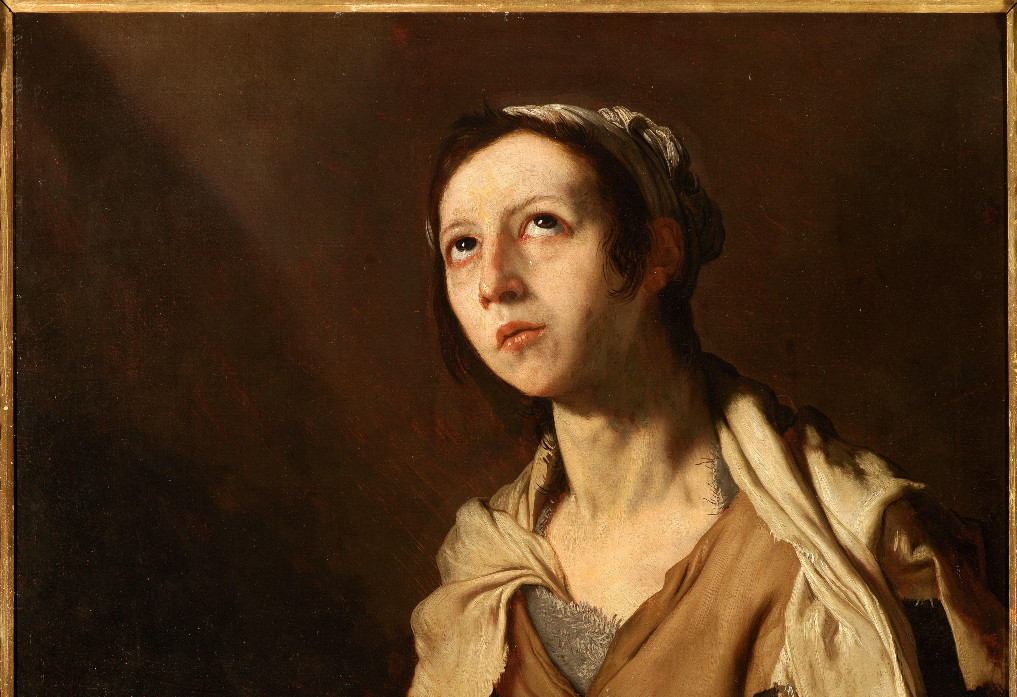
A Life of Sin and Conversion
Saint Mary of Egypt was born in the 5th century and led a life of indulgence and immorality in her youth. At a young age she became a prostitute. However, at the age of 29, she embarked on a pilgrimage to Jerusalem, looking for customers, which became a turning point in her life. As she attempted to enter the Church of the Holy Sepulchre, she was mysteriously prevented from crossing its threshold. It was in that moment that she experienced a profound revelation of her sinful life and felt a deep desire for repentance.
Moved by this encounter, Saint Mary of Egypt retreated to the desert, living as a hermit to keep herself away from men, and dedicating herself to a life of penance and spiritual purification. She settled in the wilderness near the Jordan River and embarked on a rigorous ascetic journey, engaging in constant prayer, fasting, and bodily mortification.
Spiritual Struggles and Divine Providence
Saint Mary’s years in the desert were marked by intense spiritual struggles. She encountered numerous temptations, battling with thoughts of her former way of life. Yet, through her unwavering faith and trust in God, she persevered and overcame these challenges. It is said that she lived alone in the desert for nearly five decades, relying solely on God’s providence for her sustenance and nourishment.
A Symbol of Repentance and Grace
Saint Mary of Egypt’s life embodies the power of repentance and the transformative grace of God. Her story serves as a powerful reminder that no one is beyond redemption and that true repentance can lead to profound spiritual renewal. Her example inspires believers to turn away from sinful ways and embrace a life of holiness and devotion to God.
The Last Story
According to tradition, Saint Mary of Egypt died in the desert near the Jordan River, where she had spent many years of her life as a hermit. It is believed that shortly before her death, she encountered a monk named Zosimas, who happened to be passing through the area. Saint Mary revealed her identity and shared her remarkable life story with him.
After their encounter, Saint Mary requested that Zosimas return to the same spot in the desert the following year on Holy Thursday and bring her Holy Communion. Zosimas fulfilled her request and returned to find that Saint Mary had passed away.
Zosimas buried her body with the help of a lion, which miraculously appeared to assist him in digging her grave. After burying her, Zosimas returned to his monastery and shared the extraordinary story of Saint Mary of Egypt with his fellow monks.
The exact details of Saint Mary’s death and burial are based on hagiographical accounts and oral tradition, so there may be variations in the specific details from different sources. However, the overarching narrative emphasizes her profound repentance, her life as a desert ascetic, and her eventual peaceful passing in the desert.
Veneration and Feast Day
Saint Mary of Egypt is venerated as a saint in both the Eastern Orthodox Church and the Roman Catholic Church. Her feast day is celebrated on April 1st in the Eastern Orthodox tradition and on April 2nd in the Roman Catholic tradition. On this day, believers commemorate her life, reflect on her profound repentance, and seek her intercession in their own spiritual journeys.
Continued Inspiration
Throughout the centuries, Saint Mary of Egypt’s story has captivated the hearts of believers and continues to inspire those seeking a deeper spiritual life. Her example of self-denial, perseverance, and reliance on God’s grace encourages individuals to reevaluate their own lives, embrace repentance, and embark on a path of spiritual transformation.
In conclusion, Saint Mary of Egypt stands as a remarkable figure in the history of Christian asceticism. Her life serves as a testament to the power of repentance, the strength of faith, and the transformative grace of God. As we reflect on her journey, may we find inspiration to turn away from sin, embrace a life of holiness, and seek a deeper relationship with our Creator.
8. Saint Moses the Black: The Bandit Who Became a Saint
St. Moses the Black, a former gang leader, underwent a dramatic conversion after a life of crime. His transformation into a desert monk reminds us of the transformative power of God’s mercy and forgiveness.
Saint Moses the Black, also known as Saint Moses the Ethiopian, was a prominent figure among the Desert Fathers, who dedicated themselves to a life of asceticism and spiritual growth in the deserts of Egypt. In this article, we will delve into the life of Saint Moses the Black and explore the profound asceticism practiced by the Desert Fathers.
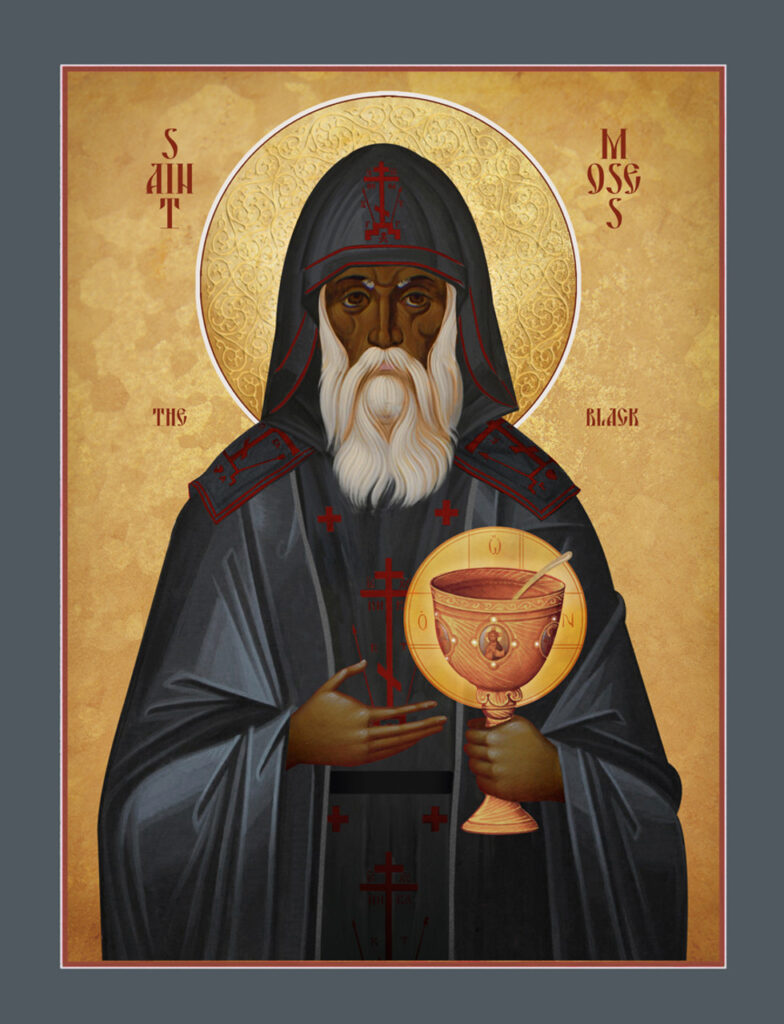
The Life of Saint Moses the Black
Saint Moses the Black was born in the fourth century as a slave in Egypt. He led a life of violence and crime, known for his involvement in robbery and even murder. However, through a series of events and encounters, he experienced a conversion and turned his life around. Inspired by the example of the Desert Fathers, he renounced his former ways and devoted himself to a life of penance and spiritual discipline.
Asceticism in the Desert
The Desert Fathers, including Saint Moses the Black, sought a life of simplicity, self-denial, and intense spiritual discipline in the harsh desert environments. They withdrew from society, living as hermits or in small communities, dedicating themselves to prayer, fasting, labor, and contemplation.
Ascetic practices among the Desert Fathers included physical mortification, such as fasting and sleep deprivation, to overcome worldly desires and focus on the pursuit of holiness. They engaged in manual labor, cultivating the land or practicing various crafts to sustain themselves and contribute to the community.
The Spiritual Teachings of Saint Moses
Saint Moses the Black, known for his wisdom and humility, became renowned among the Desert Fathers for his spiritual insight and guidance. He emphasized the importance of self-discipline, self-control, and the cultivation of virtues such as humility, patience, and love. His teachings reflected the transformative power of repentance and the pursuit of a life centered on God.
Inspiration for Modern Seekers
The ascetic practices of the Desert Fathers, exemplified by Saint Moses the Black, continue to inspire modern-day seekers of spiritual growth. Their dedication to simplicity, detachment from worldly distractions, and emphasis on inner transformation provide valuable lessons for individuals navigating the challenges of contemporary life.
By emulating their commitment to prayer, self-discipline, and the cultivation of virtues, individuals can draw closer to God, overcome spiritual obstacles, and deepen their spiritual lives.
The Enduring Legacy
Saint Moses the Black and the Desert Fathers left an indelible mark on Christian spirituality. Their ascetic practices and teachings influenced monasticism and continue to inspire individuals seeking a deeper connection with God. Their legacy serves as a reminder of the transformative power of asceticism and the pursuit of holiness in the quest for spiritual growth.
In conclusion, Saint Moses the Black stands as a shining example of the transformative power of asceticism and spiritual discipline. His life, along with the practices of the Desert Fathers, offers valuable insights for individuals seeking a more profound and meaningful spiritual journey. By embracing their teachings and incorporating elements of asceticism in our lives, we can cultivate a deeper connection with God and experience personal transformation.
9. Saint Bernadette Soubirous: The Visionary of Lourdes
St. Bernadette is renowned for her visions of the Virgin Mary in Lourdes, France. Her humility and obedience in the face of skepticism have made her an example of faithfulness and devotion.
St. Bernadette Soubirous holds a special place in Catholic history as the visionary of Lourdes, a small town in France. Her extraordinary encounters with the Virgin Mary and the subsequent events at the Grotto of Massabielle have made Lourdes a renowned site of pilgrimage and healing. In this article, we will explore the story of St. Bernadette Soubirous and the ongoing significance of Lourdes as a place of spiritual devotion and hope.
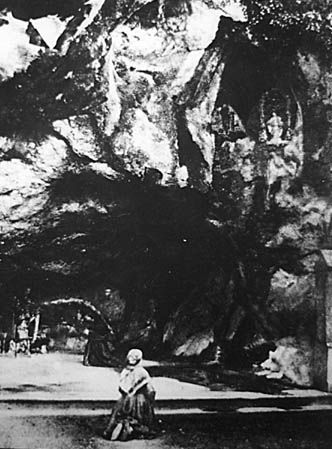
The Life of St. Bernadette Soubirous
St. Bernadette Soubirous was born in 1844 in Lourdes, a humble town in the foothills of the Pyrenees. In 1858, at the age of 14, she experienced a series of visions of a “lady” in a small grotto near the Gave de Pau river while gathering firewood. This “lady” identified herself as the Immaculate Conception, a title for the Virgin Mary.
The Apparitions and Miracles
Over a period of several months, St. Bernadette had a total of 18 visions of the lady, during which she received various messages and instructions. News of the apparitions quickly spread, and crowds began to gather at the grotto to witness these extraordinary events.
One of the most significant moments came when the lady instructed Bernadette to dig in the ground, revealing a spring that still flows today. This spring, known as the “Miraculous Spring,” has been associated with numerous healings and miracles reported by those who have visited Lourdes.
The Significance of Lourdes Today
Lourdes has become a place of pilgrimage, attracting millions of visitors from around the world. People come seeking spiritual solace, physical healing, and a deep connection with the Divine. The waters from the spring have been collected and used for bathing, as it is believed to have curative properties.
The Sanctuary of Our Lady of Lourdes, built near the grotto, encompasses several places of worship, including the Basilica of the Immaculate Conception and the Basilica of the Rosary. The “Lourdes Medical Bureau” has been established to scientifically examine reported healings and determine their authenticity.
A Source of Hope and Faith
Lourdes serves as a beacon of hope and faith, offering solace and renewal to pilgrims. The message of St. Bernadette’s visions emphasizes the power of prayer, penance, and the intercession of the Virgin Mary in our lives. It reminds us of the importance of humility, simplicity, and surrender to God’s will.
Ongoing Pilgrimages and Devotion
To this day, Lourdes continues to attract pilgrims who seek spiritual growth and healing. Numerous organized pilgrimages are conducted, providing opportunities for individuals to immerse themselves in prayer, participate in processions, and receive the sacraments.
The International Lourdes Pilgrimage takes place annually on February 11th, the World Day of the Sick, drawing pilgrims from all corners of the globe. The experience of Lourdes offers a profound encounter with the divine and a sense of community among believers.
In conclusion, St. Bernadette Soubirous’ visions in Lourdes have left an indelible mark on Catholic history. Her experiences at the grotto and the ongoing miracles associated with Lourdes continue to inspire faith, hope, and healing. Lourdes stands as a testament to the power of divine encounters and the enduring significance of spiritual devotion in our lives.
10. Saint Padre Pio: Miracles, Stigmata, and the Fragrance of Roses
Known for his piety, charity, and the mystical phenomena associated with him, St. Padre Pio of Pietrelcina served as a beacon of hope and faith in the 20th century. His life encourages us to embrace suffering with faith and love.
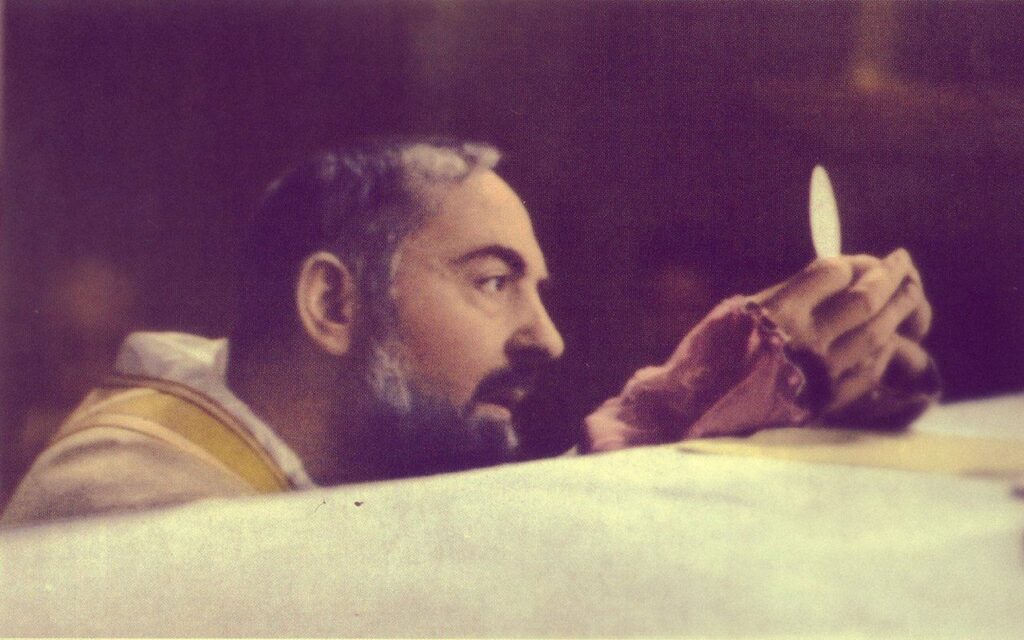
Padre Pio, also known as Saint Pio of Pietrelcina, was a revered Catholic priest and mystic who became widely known for his numerous miracles and the phenomenon of his stigmata emitting a fragrance reminiscent of roses. In this article, we will delve into the extraordinary life of Padre Pio, exploring his remarkable spiritual gifts, his stigmata, and the enduring impact of his miracles.
The Life of Padre Pio
Padre Pio was born in 1887 in Pietrelcina, Italy. Ordained as a priest in 1910, he dedicated his life to prayer, service, and the sacraments. It was during his early years as a priest that Padre Pio began experiencing supernatural phenomena, which would later become associated with his spiritual journey.
The Stigmata and the Fragrance of Roses
One of the most profound aspects of Padre Pio’s life was the manifestation of the stigmata – the wounds of Christ – on his body. Padre Pio bore the wounds of the crucifixion in his hands, feet, and side, which bled and caused him immense pain. These stigmata were visible and documented by medical professionals, providing tangible evidence of his deep union with Christ’s suffering.
What makes Padre Pio’s stigmata even more remarkable is that they were accompanied by a distinct fragrance of roses. People in his presence often reported experiencing the beautiful scent, even from a distance, as if it emanated from his wounds. The fragrance of roses became synonymous with his sanctity and is considered a sign of God’s grace and the presence of heavenly beings.
Miracles and Spiritual Gifts
Padre Pio’s life was marked by numerous miracles, both during his lifetime and after his passing. Many individuals sought his intercession and reported experiencing miraculous healings, conversions, and spiritual consolations. Padre Pio possessed several extraordinary spiritual gifts, including the ability to bilocate (being in two places at once), the gift of discernment, and the ability to read souls.
Spiritual Guidance and Confession
Padre Pio’s reputation as a spiritual guide and confessor attracted countless individuals seeking his counsel. People would travel from far and wide to seek his advice, confession, and prayers. Padre Pio offered solace, comfort, and spiritual direction to those who sought his guidance, emphasizing the importance of prayer, repentance, and devotion to God.
Canonization and Legacy
Padre Pio was canonized as a saint by Pope John Paul II in 2002, recognizing his extraordinary holiness and the impact of his life and ministry. His teachings, prayers, and example continue to inspire and transform the lives of people worldwide. Devotion to Padre Pio remains strong, with pilgrims visiting the Shrine of Padre Pio in San Giovanni Rotondo, Italy, to pay homage and seek his intercession.
A Source of Faith and Encouragement
Padre Pio’s life and miracles serve as a source of faith, encouragement, and hope for believers. His profound union with Christ’s suffering, the fragrance of roses accompanying his stigmata, and the countless testimonies of his miraculous interventions inspire individuals to embrace a deeper relationship with God and seek his mercy and love.
In conclusion, Padre Pio’s life was filled with extraordinary manifestations of divine grace, including the fragrance of roses accompanying his stigmata. His miracles, spiritual gifts, and unwavering devotion continue to inspire and strengthen the faith of believers, reminding us of the power of God’s love and the transformative impact of a life dedicated to prayer and service.
All These Amazing Catholic Saints
In the luminous tapestry of Catholic saints, we have encountered a diverse array of extraordinary individuals whose lives radiate with profound faith, unwavering devotion, and transformative love. Through their stories, we have witnessed the triumph of the human spirit, the boundless potential for holiness, and the enduring presence of the Divine in our lives.
These saints serve as beacons of inspiration, guiding us on our own spiritual journeys. Their examples teach us that sanctity is not reserved for a chosen few but is a path open to all who seek God’s love, mercy, and grace. They remind us that the call to holiness is not an abstract ideal, but a practical invitation to live authentically, to love selflessly, and to serve compassionately.
As we reflect on the lives of these remarkable individuals, let us remember that the essence of their sainthood lies not merely in the extraordinary miracles they performed or the mystical experiences they encountered, but in their unwavering commitment to God’s will and their deep love for humanity. They exemplify the transformative power of faith, inspiring us to cultivate virtues, seek spiritual growth, and embrace a life of prayer, charity, and service.
May the stories and legacies of these saints continue to resonate within our hearts, guiding us towards a deeper understanding of our own faith, and inspiring us to live lives rooted in love, compassion, and devotion. As we navigate the challenges and joys of our own journeys, let us draw strength from their example, trusting that the same grace that guided them will also illuminate our path towards a more profound union with God.
Together, let us embrace the divine presence that dwells within us and strive to emulate the virtues and holiness of these remarkable saints. For in doing so, we participate in the ongoing legacy of their lives, becoming catalysts for positive change, sources of inspiration, and bearers of God’s love in our world.
May the lives of these saints serve as a constant reminder of the transformative power of faith and the boundless capacity of the human spirit to draw closer to the Divine. Let us be inspired, let us be moved, and let us embark on our own journey of sanctity, knowing that we walk in the footsteps of those who have gone before us, and that we are not alone in our pursuit of a life rooted in God’s love.
As we bid farewell to these remarkable saints, let us carry their stories in our hearts and allow their legacies to ignite within us a renewed sense of purpose and a steadfast commitment to live as faithful disciples. For in their lives, we find the invitation to embrace the fullness of our own humanity and to radiate God’s light in the world.
May the intercession of these saints guide and bless us on our own pilgrimage of faith, as we continue to seek the Divine, embrace the miraculous, and live out our calling to be saints in our own time and place.
How useful was this post?
Click on a star to rate it!
Average rating / 5. Vote count:
No votes so far! Be the first to rate this post.
Author
-
Anthony Ernst is the Owner of ThreeSphere Websites, bringing over 16 years of experience in web development and digital strategy. Beyond the screen, He is a dedicated family man, a married father of five who thrives on balancing work, play, and personal growth. On Futura Feed, Anthony shares insights from his diverse passions, blending technology, strategy, and personal development.
View all posts Web Developer

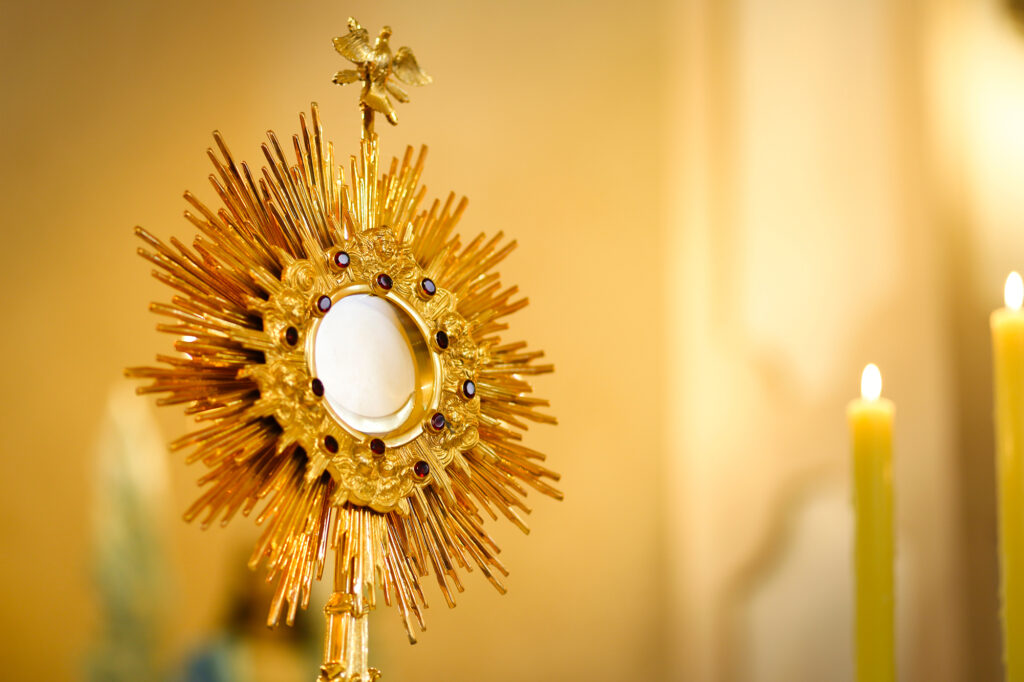






Visitor Rating: 5 Stars
Visitor Rating: 5 Stars